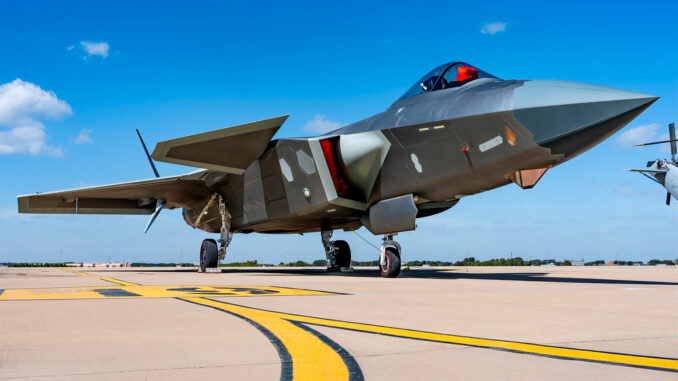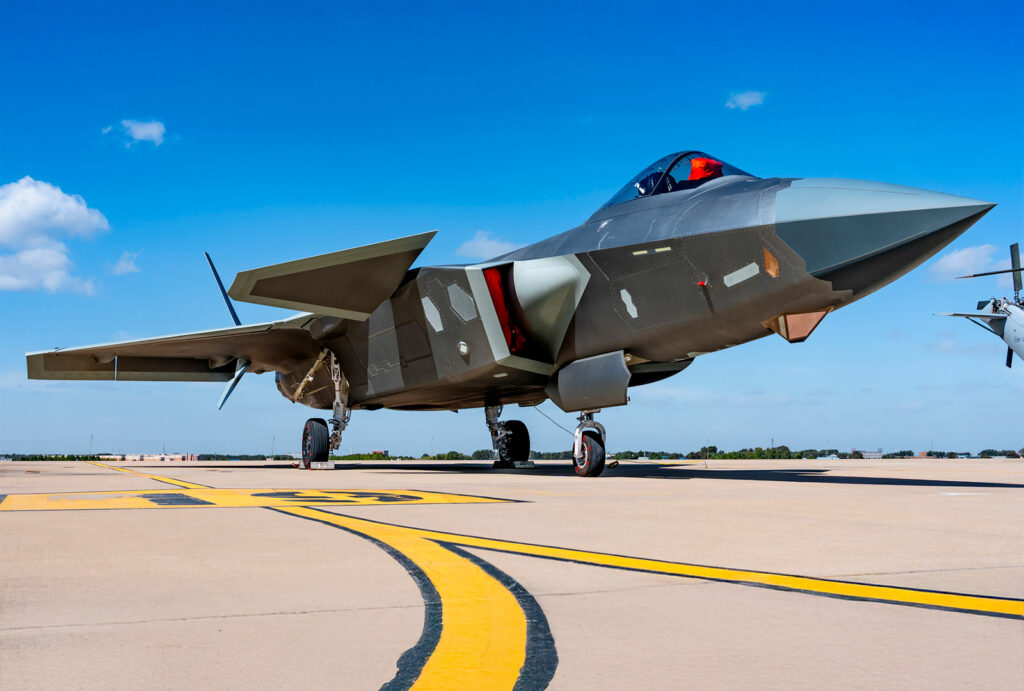
The PLAAF is upgrading its J-20 fleet to threaten US installations in the Pacific and shift the air power balance.
In summary
The Chinese Air Force (People’s Liberation Army Air Force – PLAAF) is accelerating the modernization of its Chengdu J-20 stealth aircraft, now estimated to number more than 300 in service. This ramp-up is accompanied by technical upgrades—new domestic engines, thrust vectors, greater weapons carrying capacity—aimed at degrading U.S. air superiority in the “first island chain” of the western Pacific. The goal is to have an early strike capability against US or allied bases before their forces can ramp up. Against a backdrop of high tensions in the South China Sea, this development is changing the game in terms of air and defense strategy in the Indo-Pacific region.
The massive deployment of the J-20 and its implications
The J-20 “Mighty Dragon” entered service with the PLAAF in 2017 and, according to the most recent estimates, the fleet is expected to exceed 300 aircraft by the end of 2025. This volume now constitutes the largest 5th generation fleet outside the United States. The production rate is estimated at 70 to 100 units per year, or even more according to some sources.
This massive deployment reflects several strategic choices. First, it allows China to cover its maritime theaters—East and South China—more extensively with a stealth fighter capable of both air interdiction and strike. Second, it forces the United States and its allies into a “short window” of engagement before the PLAAF can saturate the enemy’s air defenses. The development of bases near the South China Sea or China’s Pacific coast gives China a geographical advantage, reducing engagement times.
Major technical improvements to the J-20
The modernization of the J-20 involves several technical aspects:
- The domestic Shenyang WS-15 engine, capable of approximately 180 kN of thrust, is now in series production according to sources. This enables “supercruise” (supersonic flight without afterburners) and improves maneuverability.
- The installation of thrust vectoring nozzles (TVC) improves maneuverability in close engagements.
- Increased internal and external munitions capacity. For example, images from September 2025 show a J-20 equipped with eight external long-range air-to-air missiles, bringing its total capacity to 14 missiles in this mode.
- The development of the two-seat J-20S variant, intended for command or manned-unmanned teaming missions (piloting swarms of drones).
- Increased integration of network sensors and “cooperative engagement” doctrine, so that the J-20 acts not only as a fighter but also as an air command node.
These developments enhance the J-20’s ability to penetrate enemy territory, detect or neutralize radar surveillance aircraft and refueling aircraft, and carry out strikes against forward bases.

The concept of early strike and the “first island chain”
China’s strategic concept is to launch a pre-emptive strike against enemy bases, also known as the “first island chain” — a series of islands stretching from Japan and Okinawa to the Philippines, Taiwan, and the South China Sea. By striking from this area, the Chinese air force could threaten US or allied installations, disrupt supplies, and undermine the enemy’s air superiority before a major conflict.
One report notes that the PLAAF now favors attacking US “enablers” (refueling aircraft, AWACS, tankers) in addition to simply seeking air superiority. Thanks to its long range, stealth capabilities, and modernization, the J-20 is described as “optimized for this type of mission.” This strategy is consistent with China’s anti-access/area-denial (A2/AD) doctrine, which aims to repel US intervention in areas close to its coastline.
The impact on the air balance in the Pacific
The rise of the modified and massively deployed J-20 is upsetting the air balance. Until recently, the US had clear superiority thanks to its stealth aircraft (F-22 Raptor, F-35 Lightning II) and its alliance networks. But the rapid production of the J-20 and its technical upgrade mean that China is mass-producing 5th generation capabilities—an asset that has been rare until now.
The fact that the fleet exceeds 300 aircraft indicates that China now has a significant number of stealth fighters, allowing for a large presence, rotation, and potential saturation. In addition, a modernized fighter capable of striking helps reduce the US “window of vulnerability” in the region. The US Air Force and its allies will have to adapt their tactics, bases, and supplies accordingly, or risk seeing their backup forces quickly overwhelmed in the event of a crisis.
Limitations and challenges
Despite this progress, questions remain. The stealth capabilities of the J-20, although improved, are still criticized by some analysts: its radar can be identified by US systems. Its long-term operational control in an intense conflict remains to be tested. China will also have to resolve mass logistics, maintenance of the new WS-15 engines, combat training for its pilots, and the integration of swarm drones. The fact that an aircraft can fly does not guarantee that it can carry out all its missions in a high-intensity war scenario.
On the other hand, dependence on a favorable geographical context (the first chain of islands close to Chinese bases) raises questions: as soon as the engagement zone moves further away or expands, logistics, air-to-air refueling, and distant targets become more complex. Finally, the credibility of an early strike also depends on the enemy’s basic capabilities (radar, fighters, air defense) and on the anticipated response of the US or its allies.
Lessons for US allies and Indo-Pacific strategy
For the United States Air Force and its partners, the rise of the J-20 requires urgent adaptation. One article notes that China is working to increase the number of long-range missiles carried on board, develop “cooperative engagement” tactics, and align its air and naval capabilities.
Possible actions include strengthening detection capabilities, increasing the number of dispersal bases, accelerating the modernization of the F-22 and F-35, improving refueling and electronic warfare capabilities, and tightening information sharing between allies. Regional allies must also consider acquiring or deploying new-generation stealth fighters or complementary capabilities (drones, long-range missiles). Time is on China’s side, given its high production rate and constant investment.
This picture presents a reality: Chinese aviation is no longer content with a defensive posture, but is turning toward active projection in the immediate vicinity of strategic areas. The modernized J-20 is becoming an instrument of this ambition and is changing the game in the first island chain. Regional players can no longer rely on old certainties: American air superiority must be continually renewed to remain credible.
War Wings Daily is an independant magazine.